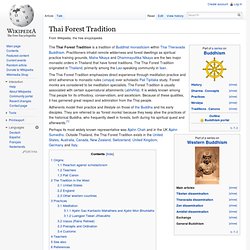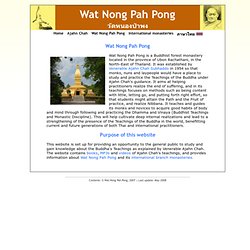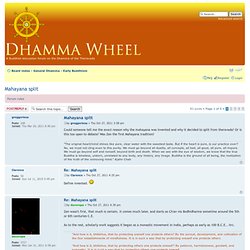

Theravada.
Meditation Centers (Laity) Thai Forest Tradition. The Thai Forest Tradition is a tradition of Buddhist monasticism within Thai Theravada Buddhism.

Practitioners inhabit remote wilderness and forest dwellings as spiritual practice training grounds. Maha Nikaya and Dhammayuttika Nikaya are the two major monastic orders in Thailand that have forest traditions. The Thai Forest Tradition originated in Thailand, primarily among the Lao-speaking community in Isan. The Thai Forest Tradition emphasizes direct experience through meditation practice and strict adherence to monastic rules (vinaya) over scholastic Pali Tipitaka study.
Forest monks are considered to be meditation specialists. The Customs of the Noble Ones, Thanissaro Bhikku. Ajahn Chah. Chah Subhaddo (Chao Khun Bodhinyana Thera) (Thai: ชา สุภัทโท, alternatively Achaan Chah, occasionally with honorific titles Luang Por and Phra; 17 June 1918 – 16 January 1992) was an influential teacher of the Buddhadhamma and a founder of two major monasteries in the Thai Forest Tradition.

Respected and loved in his own country as a man of great wisdom, he was also instrumental in establishing Theravada Buddhism in the West. Beginning in 1979 with the founding of Cittaviveka (commonly known as Chithurst Buddhist Monastery) [1] in the United Kingdom, the Thai Forest Tradition of Ajahn Chah has spread throughout Europe, the United States and the British Commonwealth. The dhamma talks of Ajahn Chah have been recorded, transcribed and translated into several languages.
More than one million people, including the Thai royal family, attended Ajahn Chah's funeral in 1992.[2] He left behind a legacy of dhamma talks, students, and monasteries. Early life[edit] Thai forest tradition[edit] Wat Nong Pah Pong - วัดหนองป่าพง. Wat Nong Pah Pong Wat Nong Pah Pong is a Buddhist forest monastery located in the province of Ubon Rachathani, in the North-East of Thailand.

It was established by Venerable Ajahn Chah Subhaddo in 1954 so that monks, nuns and laypeople would have a place to study and practice the Teachings of the Buddha under Ajahn Chah's guidance. It aims at helping practitioners realize the end of suffering, and in its teachings focuses on methods such as being content with little, letting go, and putting forth right effort, so that students might attain the Path and the Fruit of practice, and realize Nibbana. Wat Pah Nanachat. Forest Sangha. A challenge.
Abhayagiri Buddhist Monastery. Kloster Dhammapala: Besinnung - Ergründung - Entfaltung. Cittaviveka Chithurst Buddhist M. Aruna Ratanagiri Monastery. Muttodaya - forest monastery in germany. The Mindful Way - Buddhist Monks of the Forest Tradition in Thailand with Ajahn Chah. Mahayana. Mahāyāna (Sanskrit: महायान mahāyāna, literally the "Great Vehicle") is one of two (or three, under some classifications) main existing branches of Buddhism and a term for classification of Buddhist philosophies and practice.

The Buddhist tradition of Vajrayana is sometimes classified as a part of Mahayana Buddhism, but some scholars may consider it as a different branch altogether.[1] According to the teachings of Mahāyāna traditions, "Mahāyāna" also refers to the path of the Bodhisattva seeking complete enlightenment for the benefit of all sentient beings, also called "Bodhisattvayāna", or the "Bodhisattva Vehicle. "[2][note 1] A bodhisattva who has accomplished this goal is called a samyaksaṃbuddha, or "fully enlightened Buddha. " A samyaksaṃbuddha can establish the Dharma and lead disciples to enlightenment.
The Mahāyāna tradition is the largest major tradition of Buddhism existing today, with 53.2% of practitioners, compared to 35.8% for Theravāda and 5.7% for Vajrayāna in 2010.[3]
Buddhism. Whose Buddhism is Truest Tricycle Summer 2011. View topic - Mahayana split. Greggorious wrote:Could someone tell me the exact reason why the mahayana was invented and why it decided to split from theravada?

Or is this too open to debate? Was Zen the first Mahayana tradition? It's a HUGE topic, Gregorious -- one which could fill up hundreds of pages. And the bottom line is no one is really certain how it got started. The current thinking, as I understand it, is that Mahayana probably first developed as a sort of specialized focus among monastics during the centuries after the Buddha's parinibbana. Mahayana may also have a particuarly close connection with one of the early Buddhist schools, the Mahasamghika. Here's a quick-and-dirty overview (i.e. Buddhism - The Four Noble Truths, The Eightfold Path, Karma and Meditation Practice.
The Noble Eightfold Path: The Way to the End of Suffering. Practicing with the Five Hindrances. The Five Hindrances are negative mental states that impede our practice and lead us toward unwholesome action.

All of us have no doubt experienced how sensual desire, anger, sloth, restlessness, and doubt can overtake our minds—not to mention our meditation practice. These negative mind states have enormous potency, and it is difficult to pry ourselves loose from their grasp. In fact, sometimes we take perverse pleasure in indulging them, which of course makes them doubly difficult to overcome. We nurture desire for an inappropriate person; we brood over an argument with a friend; we content ourselves with an outmoded routine or relationship; we obsessively second-guess even the smallest of decisions; we allow ourselves to be consumed with doubts rather than resolving them. The Seven Factors of Enlightenment. The Tipitaka, the Buddhist canon, is replete with references to the factors of enlightenment expounded by the Enlightened One on different occasions under different circumstances.

In the Book of the Kindred Sayings, V (Samyutta Nikaya, Maha Vagga) we find a special section under the title Bojjhanga Samyutta wherein the Buddha discourses on the bojjhangas in diverse ways. In this section we read a series of three discourses or sermons recited by Buddhists since the time of the Buddha as a protection (paritta or pirit) against pain, disease, and adversity. The term bojjhanga is composed of bodhi + anga.
Bodh denotes enlightenment — to be exact, insight concerned with the realization of the four Noble Truths, namely: the Noble Truth of suffering; the Noble Truth of the origin of suffering; the Noble Truth of the cessation of suffering and the Noble Truth of the path leading to the cessation of suffering. Anga means factors or limbs. "Bojjhanga! The seven factors are: "Mindfulness. "Calm... The Ten Perfections: A Study Guide. In the early centuries after the Buddha's passing away, as Buddhism became a popular religion, the idea was formalized that there were three paths to awakening to choose from: the path to awakening as a disciple of a Buddha (savaka); the path to awakening as a private Buddha (pacceka-buddha), i.e., one who attained awakening on his own but was not able to teach the path of practice to others; and the path to awakening as a Rightly Self-awakened Buddha (samma sambuddha).
Each path was defined as consisting of perfections (paramī) of character, but there was a question as to what those perfections were and how the paths differed from one another. The Theravadins, for instance, specified ten perfections, and organized their Jataka collection so that it culminated in ten tales, each illustrating one of the perfections. The Sarvastivadins, on the other hand, specified six perfections, and organized their Jataka collection accordingly. §1. Three types of discernment — Dhp 63 §3. . §4. . §5. . §6.